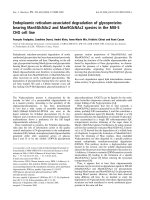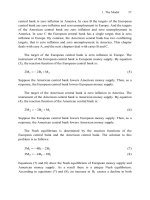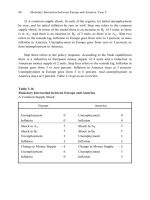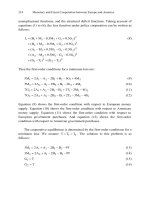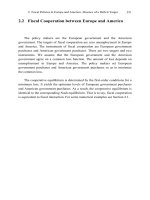Monetary and Fiscal Strategies in the World Economy by Michael Carlberg_8 doc
Bạn đang xem bản rút gọn của tài liệu. Xem và tải ngay bản đầy đủ của tài liệu tại đây (1.37 MB, 31 trang )
251
2.2 Fiscal Cooperation between Europe and America
The policy makers are the European government and the American
government. The targets of fiscal cooperation are zero unemployment in Europe
and America. The instruments of fiscal cooperation are European government
purchases and American government purchases. There are two targets and two
instruments. We assume that the European government and the American
government agree on a common loss function. The amount of loss depends on
unemployment in Europe and America. The policy makers set European
government purchases and American government purchases so as to minimize
the common loss.
The cooperative equilibrium is determined by the first-order conditions for a
minimum loss. It yields the optimum levels of European government purchases
and American government purchases. As a result, the cooperative equilibrium is
identical to the corresponding Nash equilibrium. That is to say, fiscal cooperation
is equivalent to fiscal interaction. For some numerical examples see Section 2.1.
2. Fiscal Policies in Europe and America: Absence of a Deficit Target
252
3. Fiscal Policies in Europe and America:
Presence of a Deficit Target
3.1. Fiscal Interaction between Europe and America
1) The model. An increase in European government purchases lowers
European unemployment. On the other hand, it raises European inflation. And
what is more, it raises the European structural deficit. Correspondingly, an
increase in American government purchases lowers American unemployment.
On the other hand, it raises American inflation. And what is more, it raises the
American structural deficit. An essential point is that fiscal policy in Europe has
spillover effects on America and vice versa. An increase in European
government purchases lowers American unemployment and raises American
inflation. Similarly, an increase in American government purchases lowers
European unemployment and raises European inflation.
In the numerical example, a unit increase in European government purchases
lowers European unemployment by 1 percentage point. On the other hand, it
raises European inflation by 1 percentage point. And what is more, it raises the
European structural deficit by 1 percentage point. A unit increase in European
government purchases lowers American unemployment by 0.5 percentage points
and raises American inflation by 0.5 percentage points. However, it has no effect
on the American structural deficit.
For instance, let European unemployment be 2 percent, let European
inflation be 2 percent, and let the European structural deficit be 2 percent as well.
Further, let American unemployment be 2 percent, let American inflation be 2
percent, and let the American structural deficit be 2 percent as well. Now
consider a unit increase in European government purchases. Then European
unemployment goes from 2 to 1 percent. European inflation goes from 2 to 3
percent. And the European structural deficit goes from 2 to 3 percent as well.
American unemployment goes from 2 to 1.5 percent. American inflation goes
from 2 to 2.5 percent. And the American structural deficit stays at 2 percent.
Conclusion
253
The targets of the European government are zero unemployment and a zero
structural deficit in Europe. The instrument of the European government is
European government purchases. There are two targets but only one instrument,
so what is needed is a loss function. We assume that the European government
has a quadratic loss function. The amount of loss depends on unemployment and
the structural deficit in Europe. The European government sets European
government purchases so as to minimize its loss. From this follows the reaction
function of the European government. Suppose the American government raises
American government purchases. Then, as a response, the European government
lowers European government purchases.
The targets of the American government are zero unemployment and a zero
structural deficit in America. The instrument of the American government is
American government purchases. There are two targets but only one instrument,
so what is needed is a loss function. We assume that the American government
has a quadratic loss function. The amount of loss depends on unemployment and
the structural deficit in America. The American government sets American
government purchases so as to minimize its loss. From this follows the reaction
function of the American government. Suppose the European government raises
European government purchases. Then, as a response, the American government
lowers American government purchases.
The Nash equilibrium is determined by the reaction functions of the
European government and the American government. It yields the equilibrium
levels of European government purchases and American government purchases.
As a rule, unemployment in Europe and America is not zero. And the structural
deficits in Europe and America are not zero either.
2) A demand shock in Europe. We assume equal weights in each of the loss
functions. Let initial unemployment in Europe be 3 percent, and let initial
unemployment in America be zero percent. Let initial inflation in Europe be – 3
percent, and let initial inflation in America be zero percent. Let the initial
structural deficit in Europe be zero percent, and let the initial structural deficit in
America be the same.
Step one refers to the policy response. According to the Nash equilibrium
there is an increase in European government purchases of 1.6 units and a
3. Fiscal Policies in Europe and America: Presence of a Deficit Target
254
reduction in American government purchases of 0.4 units. Step two refers to the
outside lag. Unemployment in Europe goes from 3 to 1.6 percent.
Unemployment in America goes from zero to – 0.4 percent. Inflation in Europe
goes from – 3 to – 1.6 percent. Inflation in America goes from zero to 0.4
percent. The structural deficit in Europe goes from zero to 1.6 percent. And the
structural deficit in America goes from zero to – 0.4 percent. For a synopsis see
Table 9.7.
Table 9.7
Fiscal Interaction between Europe and America
A Demand Shock in Europe
Europe America
Unemployment 3 Unemployment 0
Inflation
− 3
Inflation 0
Structural Deficit 0 Structural Deficit 0
Change in Govt Purchases 1.6 Change in Govt Purchases
− 0.4
Unemployment 1.6 Unemployment
− 0.4
Inflation
− 1.6
Inflation 0.4
Structural Deficit 1.6 Structural Deficit
− 0.4
First consider the effects on Europe. As a result, given a demand shock in
Europe, fiscal interaction lowers unemployment and deflation in Europe. On the
other hand, it raises the structural deficit there. Second consider the effects on
America. As a result, fiscal interaction produces overemployment and inflation in
America. And what is more, it produces a structural surplus there.
Conclusion
255
3.2. Fiscal Cooperation between Europe and America
1) The model. The policy makers are the European government and the
American government. The targets of fiscal cooperation are zero unemployment
and a zero structural deficit in each of the regions. The instruments of fiscal
cooperation are European government purchases and American government
purchases. There are four targets but only two instruments, so what is needed is a
loss function. We assume that the European government and the American
government agree on a common loss function. The amount of loss depends on
unemployment and the structural deficit in each of the regions. The policy
makers set European government purchases and American government purchases
so as to minimize the common loss.
The cooperative equilibrium is determined by the first-order conditions for a
minimum loss. It yields the optimum levels of European government purchases
and American government purchases.
2) A demand shock in Europe. We assume equal weights in the loss function.
Let initial unemployment in Europe be 3 percent, and let initial unemployment in
America be zero percent. Let initial inflation in Europe be – 3 percent, and let
initial inflation in America be zero percent. Let the initial structural deficit in
Europe be zero percent, and let the initial structural deficit in America be the
same.
Step one refers to the policy response. What is needed, according to the
model, is an increase in European government purchases of 1.29 units and an
increase in American government purchases of 0.09 units. Step two refers to the
outside lag. Unemployment in Europe goes from 3 to 1.66 percent.
Unemployment in America goes from zero to – 0.74 percent. Inflation in Europe
goes from – 3 to – 1.66 percent. Inflation in America goes from zero to 0.74
percent. The structural deficit in Europe goes from zero to 1.29 percent. And the
structural deficit in America goes from zero to 0.09 percent. For an overview see
Table 9.8.
3. Fiscal Policies in Europe and America: Presence of a Deficit Target
256
First consider the effects on Europe. As a result, given a demand shock in
Europe, fiscal cooperation lowers unemployment and deflation in Europe. On the
other hand, it raises the structural deficit there. Second consider the effects on
America. As a result, fiscal cooperation produces overemployment and inflation
in America. And what is more, it produces a structural deficit there.
Table 9.8
Fiscal Cooperation between Europe and America
A Demand Shock in Europe
Europe America
Unemployment 3 Unemployment 0
Inflation
− 3
Inflation 0
Structural Deficit 0 Structural Deficit 0
Change in Govt Purchases 1.29 Change in Govt Purchases 0.09
Unemployment 1.66 Unemployment
− 0.74
Inflation
− 1.66
Inflation 0.74
Structural Deficit 1.29 Structural Deficit 0.09
3) Comparing fiscal interaction and fiscal cooperation. As a result, the
cooperative equilibrium is different from the Nash equilibrium. In the numerical
example, fiscal cooperation is superior to fiscal interaction.
Conclusion
257
4. Monetary and Fiscal Policies in Europe and America:
Absence of a Deficit Target
4.1. Monetary and Fiscal Interaction
between Europe and America
An increase in European money supply lowers European unemployment. On
the other hand, it raises European inflation. Correspondingly, an increase in
American money supply lowers American unemployment. On the other hand, it
raises American inflation. An essential point is that monetary policy in Europe
has spillover effects on America and vice versa. An increase in European money
supply raises American unemployment and lowers American inflation.
Similarly, an increase in American money supply raises European unemploy-
ment and lowers European inflation.
An increase in European government purchases lowers European unemploy-
ment. On the other hand, it raises European inflation. Correspondingly, an
increase in American government purchases lowers American unemployment.
On the other hand, it raises American inflation. An essential point is that fiscal
policy in Europe has spillover effects on America and vice versa. An increase in
European government purchases lowers American unemployment and raises
American inflation. Similarly, an increase in American government purchases
lowers European unemployment and raises European inflation.
A unit increase in European money supply lowers European unemployment
by 1 percentage point. On the other hand, it raises European inflation by 1
percentage point. And what is more, a unit increase in European money supply
raises American unemployment by 0.5 percentage points and lowers American
inflation by 0.5 percentage points. A unit increase in European government
purchases lowers European unemployment by 1 percentage point. On the other
hand, it raises European inflation by 1 percentage point. And what is more, a unit
increase in European government purchases lowers American unemployment by
0.5 percentage points and raises American inflation by 0.5 percentage points.
4. Monetary and Fiscal Policies in Europe and America
258
To illustrate this there are two numerical examples. First consider an
increase in European money supply.
For instance, let European unemployment
be 2 percent, and let European inflation be 2 percent as well. Further, let
American unemployment be 2 percent, and let American inflation be 2 percent
as well. Now consider a unit increase in European money supply. Then
European unemployment goes from 2 to 1 percent. On the other hand, European
inflation goes from 2 to 3 percent. And what is more, American unemployment
goes from 2 to 2.5 percent, and American inflation goes from 2 to 1.5 percent.
Second consider an increase in European government purchases. For
instance, let European unemployment be 2 percent, and let European inflation be
2 percent as well. Further, let American unemployment be 2 percent, and let
American inflation be 2 percent as well. Now consider a unit increase in
European government purchases. Then European unemployment goes from 2 to
1 percent. On the other hand, European inflation goes from 2 to 3 percent. And
what is more, American unemployment goes from 2 to 1.5 percent, and
American inflation goes from 2 to 2.5 percent.
As to policy targets there are two distinct cases. In case A the target of the
European central bank is zero inflation in Europe. The target of the American
central bank is zero inflation in America. The target of the European government
is zero unemployment in Europe. And the target of the American government is
zero unemployment in America. In case B the targets of the European central
bank are zero inflation and zero unemployment in Europe. The targets of the
American central bank are zero inflation and zero unemployment in America.
The target of the European government is zero unemployment in Europe. And
the target of the American government is zero unemployment in America.
1) Case A.
The target of the European central bank is zero inflation in
Europe. The instrument of the European central bank is European money supply.
From this follows the reaction function of the European central bank. Suppose
the American central bank lowers American money supply. Then, as a response,
the European central bank lowers European money supply. Suppose the
European government raises European government purchases. Then, as a
response, the European central bank lowers European money supply. Suppose
the American government raises American government purchases. Then, as a
response, the European central bank lowers European money supply.
Conclusion
259
The target of the American central bank is zero inflation in America. The
instrument of the American central bank is American money supply. From this
follows the reaction function of the American central bank. The target of the
European government is zero unemployment in Europe. The instrument of the
European government is European government purchases. From this follows the
reaction function of the European government. The target of the American
government is zero unemployment in America. The instrument of the American
government is American government purchases. From this follows the reaction
function of the American government. Suppose the European central bank
lowers European money supply. Then, as a response, the European government
raises European government purchases, the American central bank lowers
American money supply, and the American government lowers American
government purchases.
The Nash equilibrium is determined by the reaction functions of the
European central bank, the American central bank, the European government,
and the American government. As an important result, in case A, there is no
Nash equilibrium.
2) Case B. The targets of the European central bank are zero inflation and
zero unemployment in Europe. The instrument of the European central bank is
European money supply. There are two targets but only one instrument, so what
is needed is a loss function. We assume that the European central bank has a
quadratic loss function. The amount of loss depends on inflation and
unemployment in Europe. The European central bank sets European money
supply so as to minimize its loss. From this follows the reaction function of the
European central bank.
The targets of the American central bank are zero inflation and zero
unemployment in America. The instrument of the American central bank is
American money supply. There are two targets but only one instrument, so what
is needed is a loss function. We assume that the American central bank has a
quadratic loss function. The amount of loss depends on inflation and
unemployment in America. The American central bank sets American money
supply so as to minimize its loss. From this follows the reaction function of the
American central bank.
4. Monetary and Fiscal Policies in Europe and America
260
The target of the European government is zero unemployment in Europe.
The instrument of the European government is European government purchases.
From this follows the reaction function of the European government. The target
of the American government is zero unemployment in America. The instrument
of the American government is American government purchases. From this
follows the reaction function of the American government.
The Nash equilibrium is determined by the reaction functions of the
European central bank, the American central bank, the European government,
and the American government. As an important result, in case B, there is no
Nash equilibrium.
4.2. Monetary and Fiscal Cooperation
between Europe and America
1) The model. The policy makers are the European central bank, the
American central bank, the European government, and the American
government. The targets of policy cooperation are zero inflation in Europe, zero
inflation in America, zero unemployment in Europe, and zero unemployment in
America. The instruments of policy cooperation are European money supply,
American money supply, European government purchases, and American
government purchases. There are four targets and four instruments. We assume
that the policy makers agree on a common loss function. The amount of loss
depends on inflation and unemployment in each of the regions. The policy
makers set European money supply, American money supply, European
government purchases, and American government purchases so as to minimize
the common loss.
The cooperative equilibrium is determined by the first-order conditions for a
minimum loss. It yields the optimum levels of European money supply,
American money supply, European government purchases, and American
Conclusion
261
government purchases. As a result there is an infinite number of solutions. Put
another way, monetary and fiscal cooperation can reduce the loss caused by
inflation and unemployment.
2) A demand shock in Europe. We assume equal weights in the loss
function. Let initial unemployment in Europe be 3 percent, and let initial
unemployment in America be zero percent. Let initial inflation in Europe be – 3
percent, and let initial inflation in America be zero percent. Step one refers to the
policy response. According to the model, a first solution is an increase in
European money supply of 4 units, an increase in American money supply of 2
units, no change in European government purchases, and no change in American
government purchases. Step two refers to the outside lag. Unemployment in
Europe goes from 3 to zero percent. Unemployment in America stays at zero
percent. Inflation in Europe goes from – 3 to zero percent. And inflation in
America stays at zero percent. Table 9.9 presents a synopsis.
Table 9.9
Monetary and Fiscal Cooperation between Europe and America
A Demand Shock in Europe
Europe America
Unemployment 3 Unemployment 0
Inflation
− 3
Inflation 0
Change in Money Supply 4 Change in Money Supply 2
Change in Govt Purchases 0 Change in Govt Purchases 0
Unemployment 0 Unemployment 0
Inflation 0 Inflation 0
A second solution is no change in European money supply, no change in
American money supply, an increase in European government purchases of 4
units, and a reduction in American government purchases of 2 units. A third
4. Monetary and Fiscal Policies in Europe and America
262
solution is an increase in European money supply of 2 units, an increase in
American money supply of 1 unit, an increase in European government
purchases of 2 units, and a reduction in American government purchases of 1
unit. As a result, given a demand shock in Europe, monetary and fiscal
cooperation produces zero inflation and zero unemployment in each of the
regions.
3) A supply shock in Europe. Let initial inflation in Europe be 3 percent, and
let initial inflation in America be zero percent. Let initial unemployment in
Europe be 3 percent, and let initial unemployment in America be zero percent.
Step one refers to the policy response. According to the model, a first solution is
no change in European money supply, no change in American money supply, no
change in European government purchases, and no change in American
government purchases. As a result, given a supply shock in Europe, monetary
and fiscal cooperation is ineffective.
4) A mixed shock in Europe. Let initial inflation in Europe be 6 percent, and
let initial inflation in America be zero percent. Let initial unemployment in
Europe be zero percent, and let initial unemployment in America be the same.
Step one refers to the policy response. According to the model, a first solution is
a reduction in European money supply of 4 units, a reduction in American
money supply of 2 units, no change in European government purchases, and no
change in American government purchases. Step two refers to the outside lag.
Inflation in Europe goes from 6 to 3 percent. Inflation in America stays at zero
percent. Unemployment in Europe goes from zero to 3 percent. And
unemployment in America stays at zero percent. Table 9.10 gives an overview.
First consider the effects on Europe. As a result, given a mixed shock in
Europe, monetary and fiscal cooperation lowers inflation in Europe. On the other
hand, it raises unemployment there. Second consider the effects on America. As
a result, monetary and fiscal cooperation produces zero inflation and zero
unemployment in America.
5) Comparing policy interaction and policy cooperation. Under policy
interaction there is no Nash equilibrium. By contrast, under policy cooperation,
the loss can be brought down. That is to say, policy cooperation seems to be
superior to policy interaction.
Conclusion
263
Table 9.10
Monetary and Fiscal Cooperation between Europe and America
A Mixed Shock in Europe
Europe America
Unemployment 0 Unemployment 0
Inflation 6 Inflation 0
Change in Money Supply
− 4
Change in Money Supply
− 2
Change in Govt Purchases 0 Change in Govt Purchases 0
Unemployment 3 Unemployment 0
Inflation 3 Inflation 0
4. Monetary and Fiscal Policies in Europe and America
264
5. Monetary and Fiscal Policies in Europe and America:
Presence of a Deficit Target
5.1. Monetary and Fiscal Interaction
between Europe and America: Case A
1) The model. An increase in European money supply lowers European
unemployment. On the other hand, it raises European inflation. Correspondingly,
an increase in American money supply lowers American unemployment. On the
other hand, it raises American inflation. An essential point is that monetary
policy in Europe has spillover effects on America and vice versa. An increase in
European money supply raises American unemployment and lowers American
inflation. Similarly, an increase in American money supply raises European
unemployment and lowers European inflation.
An increase in European government purchases lowers European unemploy-
ment. On the other hand, it raises European inflation. And what is more, it raises
the European structural deficit. Correspondingly, an increase in American
government purchases lowers American unemployment. On the other hand, it
raises American inflation. And what is more, it raises the American structural
deficit. An essential point is that fiscal policy in Europe has spillover effects on
America and vice versa. An increase in European government purchases lowers
American unemployment and raises American inflation. Similarly, an increase in
American government purchases lowers European unemployment and raises
European inflation.
A unit increase in European money supply lowers European unemployment
by 1 percentage point. On the other hand, it raises European inflation by 1
percentage point. Correspondingly, a unit increase in European government
purchases lowers European unemployment by 1 percentage point. On the other
hand, it raises European inflation by 1 percentage point. And what is more, it
raises the European structural deficit by 1 percentage point. As to the spillover
effects, a unit increase in European money supply raises American unemploy-
ment by 0.5 percentage points and lowers American inflation by 0.5 percentage
Conclusion
265
points. Conversely, a unit increase in European government purchases lowers
American unemployment by 0.5 percentage points and raises American inflation
by 0.5 percentage points.
To illustrate this there are two numerical examples. First consider an
increase in European money supply.
For instance, let European unemployment
be 2 percent, let European inflation be 2 percent, and let the European structural
deficit be 2 percent as well. Further, let American unemployment be 2 percent,
let American inflation be 2 percent, and let the American structural deficit be 2
percent as well. Now consider a unit increase in European money supply. Then
European unemployment goes from 2 to 1 percent. On the other hand, European
inflation goes from 2 to 3 percent. And the European structural deficit stays at 2
percent. What is more, American unemployment goes from 2 to 2.5 percent.
American inflation goes from 2 to 1.5 percent. And the American structural
deficit stays at 2 percent.
Second consider an increase in European government purchases.
For
instance, let European unemployment be 2 percent, let European inflation be 2
percent, and let the European structural deficit be 2 percent as well. Further, let
American unemployment be 2 percent, let American inflation be 2 percent, and
let the American structural deficit be 2 percent as well. Now consider a unit
increase in European government purchases. Then European unemployment goes
from 2 to 1 percent. On the other hand, European inflation goes from 2 to 3
percent. And the European structural deficit goes from 2 to 3 percent as well.
What is more, American unemployment goes from 2 to 1.5 percent. American
inflation goes from 2 to 2.5 percent. And the American structural deficit stays at
2 percent.
As to policy targets there are two distinct cases. In case A the target of the
European central bank is zero inflation in Europe. The target of the American
central bank is zero inflation in America. The targets of the European
government are zero unemployment and a zero structural deficit in Europe. And
the targets of the American government are zero unemployment and a zero
structural deficit in America.
In case B the targets of the European central bank are zero inflation and zero
unemployment in Europe. The targets of the American central bank are zero
5. Monetary and Fiscal Policies in Europe and America
266
inflation and zero unemployment in America. The targets of the European
government are zero unemployment and a zero structural deficit in Europe. And
the targets of the American government are zero unemployment and a zero
structural deficit in America. This section deals with case A, and the next section
deals with case B.
The target of the European central bank is zero inflation in Europe. The
instrument of the European central bank is European money supply. From this
follows the reaction function of the European central bank. Suppose the
American central bank lowers American money supply. Then, as a response, the
European central bank lowers European money supply. Suppose the European
government raises European government purchases. Then, as a response, the
European central bank lowers European money supply. Suppose the American
government raises American government purchases. Then, as a response, the
European central bank lowers European money supply.
The target of the
American central bank is zero inflation in America. The instrument of the
American central bank is American money supply. From this follows the
reaction function of the American central bank.
The targets of the European government are zero unemployment and a zero
structural deficit in Europe. The instrument of the European government is
European government purchases. There are two targets but only one instrument,
so what is needed is a loss function. We assume that the European government
has a quadratic loss function. The amount of loss depends on unemployment and
the structural deficit in Europe. The European government sets European
government purchases so as to minimize its loss. From this follows the reaction
function of the European government.
The targets of the American government are zero unemployment and a zero
structural deficit in America. The instrument of the American government is
American government purchases. There are two targets but only one instrument,
so what is needed is a loss function. We assume that the American government
has a quadratic loss function. The amount of loss depends on unemployment and
the structural deficit in America. The American government sets American
government purchases so as to minimize its loss. From this follows the reaction
function of the American government. Suppose the European government raises
European government purchases. Then, as a response, the European central bank
Conclusion
267
lowers European money supply, the American central bank lowers American
money supply, and the American government lowers American government
purchases.
The Nash equilibrium is determined by the reaction functions of the
European central bank, the American central bank, the European government,
and the American government. It yields the equilibrium levels of European
money supply, American money supply, European government purchases, and
American government purchases.
2) A demand shock in Europe. We assume equal weights in each of the loss
functions. Let initial unemployment in Europe be 3 percent, and let initial
unemployment in America be zero percent. Let initial inflation in Europe be – 3
percent, and let initial inflation in America be zero percent. Let the initial
structural deficit in Europe be zero percent, and let the initial structural deficit in
America be the same.
Step one refers to the policy response. According to the Nash equilibrium
there is an increase in European money supply of 4 units, an increase in
American money supply of 2 units, no change in European government
purchases, and no change in American government purchases. Step two refers to
the outside lag. Unemployment in Europe goes from 3 to zero percent.
Unemployment in America stays at zero percent. Inflation in Europe goes from
– 3 to zero percent. Inflation in America stays at zero percent. The structural
deficit in Europe stays at zero percent, as does the structural deficit in America.
For a synopsis see Table 9.11.
As a result, given a demand shock in Europe, monetary and fiscal interaction
produces zero inflation, zero unemployment, and a zero structural deficit in each
of the regions.
5. Monetary and Fiscal Policies in Europe and America
268
Table 9.11
Monetary and Fiscal Interaction between Europe and America
A Demand Shock in Europe
Europe America
Unemployment 3 Unemployment 0
Inflation
− 3
Inflation 0
Structural Deficit 0 Structural Deficit 0
Change in Money Supply 4 Change in Money Supply 2
Change in Govt Purchases 0 Change in Govt Purchases 0
Unemployment 0 Unemployment 0
Inflation 0 Inflation 0
Structural Deficit 0 Structural Deficit 0
3) A supply shock in Europe. Let initial inflation in Europe be 3 percent, and
let initial inflation in America be zero percent. Let initial unemployment in
Europe be 3 percent, and let initial unemployment in America be zero percent.
Let the initial structural deficit in Europe be zero percent, and let the initial
structural deficit in America be the same.
Step one refers to the policy response. According to the Nash equilibrium
there is a reduction in European money supply of 14 units, a reduction in
American money supply of 10 units, an increase in European government
purchases of 6 units, and no change in American government purchases. Step
two refers to the outside lag. Inflation in Europe goes from 3 to zero percent.
Inflation in America stays at zero percent. Unemployment in Europe goes from 3
to 6 percent. Unemployment in America stays at zero percent. The structural
deficit in Europe goes from zero to 6 percent. And the structural deficit in
America stays at zero percent. For an overview see Table 9.12.
First consider the effects on Europe. As a result, given a supply shock in
Europe, monetary and fiscal interaction produces zero inflation in Europe. On the
Conclusion
269
other hand, it raises unemployment and the structural deficit there. Second
consider the effects on America. As a result, monetary and fiscal interaction
produces zero inflation, zero unemployment, and a zero structural deficit in
America.
Table 9.12
Monetary and Fiscal Interaction between Europe and America
A Supply Shock in Europe
Europe America
Unemployment 3 Unemployment 0
Inflation 3 Inflation 0
Structural Deficit 0 Structural Deficit 0
Change in Money Supply
− 14
Change in Money Supply
− 10
Change in Govt Purchases 6 Change in Govt Purchases 0
Unemployment 6 Unemployment 0
Inflation 0 Inflation 0
Structural Deficit 6 Structural Deficit 0
4) Comparing pure monetary interaction and monetary-fiscal interaction. As
a result, in case A, the system of pure monetary interaction is superior to the
system of monetary and fiscal interaction, see Part Three.
5. Monetary and Fiscal Policies in Europe and America
270
5.2. Monetary and Fiscal Interaction
between Europe and America: Case B
1) The model. This section deals with case B. The targets of the European
central bank are zero inflation and zero unemployment in Europe. The
instrument of the European central bank is European money supply. There are
two targets but only one instrument, so what is needed is a loss function. We
assume that the European central bank has a quadratic loss function. The amount
of loss depends on inflation and unemployment in Europe. The European central
bank sets European money supply so as to minimize its loss. From this follows
the reaction function of the European central bank.
The targets of the American central bank are zero inflation and zero
unemployment in America. The instrument of the American central bank is
American money supply. There are two targets but only one instrument, so what
is needed is a loss function. We assume that the American central bank has a
quadratic loss function. The amount of loss depends on inflation and
unemployment in America. The American central bank sets American money
supply so as to minimize its loss. From this follows the reaction function of the
American central bank.
The targets of the European government are zero unemployment and a zero
structural deficit in Europe. The instrument of the European government is
European government purchases. There are two targets but only one instrument,
so what is needed is a loss function. We assume that the European government
has a quadratic loss function. The amount of loss depends on unemployment and
the structural deficit in Europe. The European government sets European
government purchases so as to minimize its loss. From this follows the reaction
function of the European government.
The targets of the American government are zero unemployment and a zero
structural deficit in America. The instrument of the American government is
American government purchases. There are two targets but only one instrument,
so what is needed is a loss function. We assume that the American government
has a quadratic loss function. The amount of loss depends on unemployment and
Conclusion
271
the structural deficit in America. The American government sets American
government purchases so as to minimize its loss. From this follows the reaction
function of the American government.
The Nash equilibrium is determined by the reaction functions of the
European central bank, the American central bank, the European government,
and the American government. It yields the equilibrium levels of European
money supply, American money supply, European government purchases, and
American government purchases.
2) A demand shock in Europe. We assume equal weights in each of the loss
functions. Let initial unemployment in Europe be 3 percent, and let initial
unemployment in America be zero percent. Let initial inflation in Europe be – 3
percent, and let initial inflation in America be zero percent. Let the initial
structural deficit in Europe be zero percent, and let the initial structural deficit in
America be the same.
Step one refers to the policy response. According to the Nash equilibrium
there is an increase in European money supply of 4 units, an increase in
American money supply of 2 units, no change in European government
purchases, and no change in American government purchases. Step two refers to
the outside lag. Unemployment in Europe goes from 3 to zero percent.
Unemployment in America stays at zero percent. Inflation in Europe goes from –
3 to zero percent. Inflation in America stays at zero percent. The structural deficit
in Europe stays at zero percent, as does the structural deficit in America. For a
synopsis see Table 9.11 above.
As a result, given a demand shock in Europe, monetary and fiscal interaction
produces zero inflation, zero unemployment, and a zero structural deficit in each
of the regions.
3) A supply shock in Europe. Let initial inflation in Europe be 3 percent, and
let initial inflation in America be zero percent. Let initial unemployment in
Europe be 3 percent, and let initial unemployment in America be zero percent.
Let the initial structural deficit in Europe be zero percent, and let the initial
structural deficit in America be the same.
5. Monetary and Fiscal Policies in Europe and America
272
Step one refers to the policy response. According to the Nash equilibrium
there is a reduction in European money supply of 5 units, a reduction in
American money supply of 4 units, an increase in European government
purchases of 3 units, and no change in American government purchases. Step
two refers to the outside lag. Inflation in Europe stays at 3 percent. Inflation in
America stays at zero percent. Unemployment in Europe stays at 3 percent.
Unemployment in America stays at zero percent. The structural deficit in Europe
goes from zero to 3 percent. And the structural deficit in America stays at zero
percent. Table 9.13 presents a synopsis.
Table 9.13
Monetary and Fiscal Interaction between Europe and America
A Supply Shock in Europe
Europe America
Unemployment 3 Unemployment 0
Inflation 3 Inflation 0
Structural Deficit 0 Structural Deficit 0
Change in Money Supply
− 5
Change in Money Supply
− 4
Change in Govt Purchases 3 Change in Govt Purchases 0
Unemployment 3 Unemployment 0
Inflation 3 Inflation 0
Structural Deficit 3 Structural Deficit 0
First consider the effects on Europe. As a result, given a supply shock in
Europe, monetary and fiscal interaction has no effects on inflation and
unemployment in Europe. And what is more, it causes a structural deficit there.
Second consider the effects on America. As a result, monetary and fiscal
interaction produces zero inflation, zero unemployment, and a zero structural
deficit in America. That is to say, the Nash equilibrium is not Pareto efficient.
Conclusion
273
4) A mixed shock in Europe. Let initial inflation in Europe be 6 percent, and
let initial inflation in America be zero percent. Let initial unemployment in
Europe and America be zero each. And let the initial structural deficit in Europe
and America be zero each.
Step one refers to the policy response. According to the Nash equilibrium
there is a reduction in European money supply of 9 units, a reduction in
American money supply of 6 units, an increase in European government
purchases of 3 units, and no change in American government purchases. Step
two refers to the outside lag. Inflation in Europe goes from 6 to 3 percent.
Inflation in America stays at zero percent. Unemployment in Europe goes from
zero to 3 percent. Unemployment in America stays at zero percent. The structural
deficit in Europe goes from zero to 3 percent. And the structural deficit in
America stays at zero percent. Table 9.14 gives an overview.
As a result, given a mixed shock in Europe, monetary and fiscal interaction
lowers inflation in Europe. On the other hand, it raises unemployment and the
structural deficit there.
Table 9.14
Monetary and Fiscal Interaction between Europe and America
A Mixed Shock in Europe
Europe America
Unemployment 0 Unemployment 0
Inflation 6 Inflation 0
Structural Deficit 0 Structural Deficit 0
Change in Money Supply
− 9
Change in Money Supply
− 6
Change in Govt Purchases 3 Change in Govt Purchases 0
Unemployment 3 Unemployment 0
Inflation 3 Inflation 0
Structural Deficit 3 Structural Deficit 0
5. Monetary and Fiscal Policies in Europe and America
274
5) Comparing monetary-fiscal interaction A and monetary-fiscal interaction
B. First consider a demand shock in Europe. In case A, policy interaction
achieves zero inflation, zero unemployment, and a zero structural deficit in each
of the regions. In case B we have the same effects. Second consider a supply
shock in Europe. In case A, policy interaction achieves zero inflation in Europe.
On the other hand, it raises unemployment and the structural deficit there. In case
B, policy interaction has no effect on inflation and unemployment in Europe.
And what is more, it causes a structural deficit there.
6) Comparing pure monetary interaction and monetary-fiscal interaction. As
a result, in case B, the system of pure monetary interaction is superior to the
system of monetary and fiscal interaction, see Part Three.
5.3. Monetary and Fiscal Cooperation
between Europe and America
1) The model. The policy makers are the European central bank, the
American central bank, the European government, and the American
government. The targets of policy cooperation are zero inflation in Europe, zero
inflation in America, zero unemployment in Europe, zero unemployment in
America, a zero structural deficit in Europe, and a zero structural deficit in
America. The instruments of policy cooperation are European money supply,
American money supply, European government purchases, and American
government purchases. There are six targets but only four instruments, so what is
needed is a loss function.
We assume that the policy makers agree on a common loss function. The
amount of loss depends on inflation, unemployment, and the structural deficit in
each of the regions. The policy makers set European money supply, American
money supply, European government purchases, and American government
purchases so as to minimize the common loss. The cooperative equilibrium is
determined by the first-order conditions for a minimum loss. It yields the
Conclusion
275
optimum levels of European money supply, American money supply, European
government purchases, and American government purchases.
2) A demand shock in Europe. We assume equal weights in the loss function.
Let initial unemployment in Europe be 3 percent, and let initial unemployment in
America be zero percent. Let initial inflation in Europe be – 3 percent, and let
initial inflation in America be zero percent. Let the initial structural deficit in
Europe be zero percent, and let the initial structural deficit in America be the
same. Step one refers to the policy response. What is needed, according to the
model, is an increase in European money supply of 4 units, an increase in
American money supply of 2 units, no change in European government
purchases, and no change in American government purchases.
Step two refers to the outside lag. Unemployment in Europe goes from 3 to
zero percent. Unemployment in America stays at zero percent. Inflation in
Europe goes from – 3 to zero percent. Inflation in America stays at zero percent.
The structural deficit in Europe stays at zero percent, as does the structural deficit
in America. For a synopsis see Table 9.15. As a result, given a demand shock in
Europe, monetary and fiscal cooperation produces zero inflation, zero
unemployment, and a zero structural deficit in each of the regions.
3) A supply shock in Europe. Let initial inflation in Europe be 3 percent, and
let initial inflation in America be zero percent. Let initial unemployment in
Europe be 3 percent, and let initial unemployment in America be zero percent. In
each of the regions let the initial structural deficit be zero percent. Step one refers
to the policy response. What is needed, according to the model, is no change in
European money supply, no change in American money supply, no change in
European government purchases, and no change in American government
purchases. As a result, given a supply shock in Europe, monetary and fiscal
cooperation is ineffective.
5. Monetary and Fiscal Policies in Europe and America


